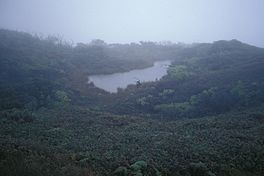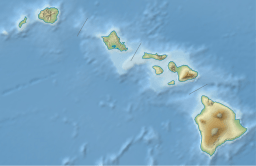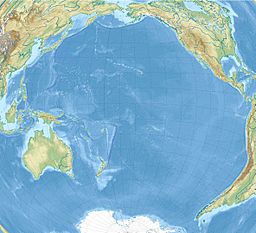Violet Lake facts for kids
Quick facts for kids Violet Lake |
|
|---|---|

Violet Lake situated in a forest of ʻōhiʻa lehua trees (Metrosideros polymorpha)
|
|
| Location | West Maui Mountains, Maui |
| Coordinates | 20°54′27″N 156°35′41″W / 20.907471°N 156.594779°W |
| Basin countries | United States |
| Surface area | 10 ft × 20 ft (3.0 m × 6.1 m) (approximate) |
| Surface elevation | 5,020 ft (1,530 m) (approximate) |
Violet Lake is a small lake high up in the mountains on the island of Maui, Hawaii. It sits about 5,020 ft (1,530 m) above sea level in the West Maui Mountains. This area is also known as Mauna Kahalawai.
The lake is quite small, only about 10 ft × 20 ft (3.0 m × 6.1 m) in size. You can find it on the wet, boggy slopes near ʻEke Crater and Puʻu Kukui. Puʻu Kukui is the highest point in the West Maui Mountains.
The lake gets its English name, Violet Lake, from two things. First, the surface of the water can look like a violet color. Second, a special kind of violet flower, called the Maui violet (Viola mauiensis), grows right on its banks. The Hawaiian name for the lake is Kiʻowaiokihawahine. This means "the pond of Kihawahine."
Contents
The Lake's Special Hawaiian History
Violet Lake was very important in the traditional Hawaiian religion. Long ago, people believed this lake and the mountains around it were sacred. They thought it was a place where heaven and earth met.
Kihawahine: A Powerful Goddess
People believed that the Hawaiian moʻo (lizard) goddess Kihawahine lived in Violet Lake. Kihawahine was a very important goddess. She was connected to the aliʻi nui, who were the high chiefs or kings of Maui.
Kihawahine was also seen as an aumakua, which means a family deity or guardian spirit. She was the aumakua of Queen Keōpūolani. Queen Keōpūolani was a descendant of the Maui royal family. She was also the highest-ranking wife of King Kamehameha I, who created the Kingdom of Hawaii. Their son, Kamehameha III, also considered Kihawahine his aumakua.
Kihawahine was also linked to a wetland area and former royal complex called Mokuʻula. This place is located in Lahaina, in the valleys below the lake.
A Unique Ecosystem
The area around Violet Lake is a montane rainforest. This means it's a rainforest found in the mountains. It's part of the Puʻu Kukui Watershed Management Area. This area is one of the wettest places in the Hawaiian Islands!
Amazing Plants and Animals
This rainforest is home to many unique plants and animals that are found nowhere else in the world. The lake itself has its own special ecosystem, but scientists haven't studied it much yet.
Some of the amazing species you might find here include:
- The dwarfed ʻōhiʻa lehua tree (Metrosideros polymorpha). These trees are smaller than usual because of the harsh mountain conditions.
- The Maui violet (Viola mauiensis), which gives the lake its name.
- Different types of Hawaiian lobelioids, like Lobelia gloriamontis. These are unique Hawaiian plants.
- Hawaiian damselflies (Megalagrion spp.). These are special insects found only in Hawaii.
People who have visited Violet Lake describe it as an "extremely rare gem." Both local residents and visiting scientists are amazed by its beauty and unique nature.



